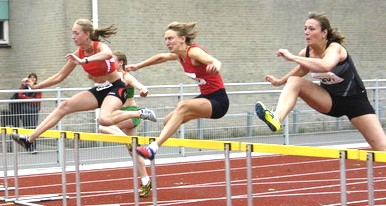Developing Hurdling Speed
 Hurdling is an odd event, for it's not a technical event, it's not really a running event either. But when it comes to speed, it is most of the time technique that is holding us back. The biggest speed challenge lies in the cyclic nature of the event, chaining one hurdle to the next, not in the perfect clearance. You can not keep perfecting the passage, at some point in time races have to be ran. That is why throughout the preparation fase the focus should slowly change from passage, perfecting the single hurdle clearance, to running, perfecting the transition from one hurdle to the next. So how do you do that.
Hurdling is an odd event, for it's not a technical event, it's not really a running event either. But when it comes to speed, it is most of the time technique that is holding us back. The biggest speed challenge lies in the cyclic nature of the event, chaining one hurdle to the next, not in the perfect clearance. You can not keep perfecting the passage, at some point in time races have to be ran. That is why throughout the preparation fase the focus should slowly change from passage, perfecting the single hurdle clearance, to running, perfecting the transition from one hurdle to the next. So how do you do that.
Major speed problems
For many, especially youngsters, the major problem when developing hurdling speed is the large distance between the hurdles. After a few hurdles the athlete gradually loses speed, rather jumping than running from one hurdle to the next. Sprint speed and hurdling technique are usually not the issue here. In most cases it's guts. The athlete is not comfortable taking off where he should, further away from the hurdle. Being to close to the hurdle the take-off is too steep, covering to little ground in the passage. This over-striding is also counter productive, they are breaking every step of the way. A simular problem effects tall hurdlers, althought the distance between hurdles doesn't seem to be a problem, they gradually slow down, as if something is holding them back. It is the same problem the short hurdlers have; they fail to take off where they have to. When they build up steed they try to increase the stride length and shorten the passage getting closer and closer to the hurdle. They just have to learn to adapt, freqency should rise, stride length should shorten and the passage should get more room.
Many hurdlers think, feel and do like hurdling is all about jumping over hurdles while running. But hurdling is about running away from the hurdles. The barrier has to be crossed in such a way we are best prepared for running away as fast as we can.
And then there are those who get stuck in the comfort zone after 4 to 5 hurdles. After accelerating hurdling feels easy here, their speed and technique are matching the distance. And before they know it they cross the finish line, "why didn't I go faster" they ask themselves. Hurdling is hard work, from start through finish.
Speed in Practise
One of the first things to focus on is the take-off distance to the hurdle. With markers on the ground it easy to monitor a correct take-off. Do not use sticks or other things an athlete could trip on or over. Remember they probably already feel challenged with a longer take-off, no need to raise the stakes. Even in early preparation when hurdles are still close to each other you can practise this drill. It can be easily combined with a lead-leg or a trail-leg only drill. In training you can use the following 'rule-of-thumb' for take-off distance; The take-off distance is approximately one-fourth the hurdle distance. When you are just starting this, use one-fifth or less.
The next thing to work on is gradually increasing hurdle distance. Slowly lift the base distance from 4m to 6m over sessions. In sessions you can work on runs with; Increasing distances every hurdle; Alternating short-long distances every hurdle; Alternating runs on short and long distances over a set of hurdles. The main focus is to keep rhythm while the stride-length varies. If frequency drops, you are increasing distance to fast. Take it slow, be patient.
The last thing to work on are the speed runs. Give the athlete extra room to speed up, during hurdling. This can be established by alternating a 3-stride pattern with a 5-stride or 7-stride pattern. These exercises require a good feel for rhythm and the hurdler has to feel confident about his take-off and the distance between hurdles. Many athletes tent to increase stride-length once they see the hurdles are further apart. They have to keep focused on frequency.
Training Samples
I always use my feet in training to space the hurdles, here are some stride-equivalents to remember. Using my feet women's hurdles (8m50) are 28 feet apart, men's hurdles (9m13) 30 feet.
| 3 stride | 5 stride | 7 stride |
| 16 feet | 24 feet | 32 feet |
| 20 feet | 30 feet | 40 feet |
| 24 feet | 36 feet | 48 feet |
| 28 feet | 42 feet | 56 feet |
The first are starter runs, the hurdles are spaced evenly here, according to the table above;
6 hurdles, stride pattern (feet apart):
After that we can do slight adjustments in spacing.
6 hurdles, stride pattern (feet apart):
At last the 'advanced' stuff.
8 hurdles, stride pattern (feet apart):
Updated 07-11-2021